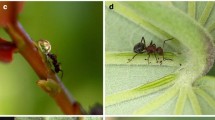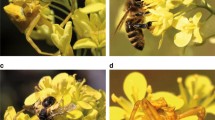Abstract
Herbivory by arthropods often induces the emission of plant volatiles, which attract natural enemies of the herbivores. This induced emission of volatiles is considered to be a strategy of plants to effectively defend against herbivores by employing bodyguards. Recent empirical research has revealed that these volatiles can also affect neighboring undamaged plants and cause them to emit volatiles secondarily. Provided that signal emission imposes some cost on plants, the evolutionary advantage to undamaged plants in the emission of such secondary signals is unclear. We hypothesized that plants have evolved to emit a secondary signal to help nearby relatives by promoting the recruitment of natural enemies, whereby they increase inclusive fitness. We constructed a simulation model to evaluate this hypothesis. Our simulations suggest that a secondary signal evolves if the following five conditions are met: the cost of the signal is low; the potential risk of infestation is high; the attractiveness of the signal to natural enemies is highly positively correlated with the local density of the signal chemical; dispersal of offspring is spatially restricted, causing population viscosity, and; sufficient vacant space is available, allowing the population to be elastic.




Similar content being viewed by others
References
Birkett MA, Campbell CAM, Chamberlain K, Guerrieri E, Hick AJ, Martin JL, Matthes M, Napier JA, Pettersson J, Pickett JA, Poppy GM, Pow EM, Pye BJ, Smart LE, Wadhams GH, Wadhams LJ, Woodcock CM (2000) New roles for cis-jasmone as an insect semiochemical and in plant defense. Proc Natl Acad Sci USA 97:9329–9334
Bruin J, Dicke M, Sabelis MW (1992) Plants are better protected against spider-mites after exposure to volatiles from infested conspecifics. Experientia 48:525–529
Chamberlain K, Guerrieri E, Pennacchio F, Pettersson J, Pickett JA, Poppy GM, Powell W, Wadhams LJ, Woodcock CM (2001) Can aphid-induced plant signals be transmitted aerially and through the rhizosphere? Biochem Syst Ecol 29:1063–1074
Choh Y, Shimoda T, Ozawa R, Dicke M, Takabayashi J (2004) Exposure of lima bean leaves to volatiles from herbivore-induced conspecific plants results in emission of carnivore attractants: active or passive process? J Chem Ecol 30:1305–1317
Dicke M (1999) Evolution of induced indirect defense of plants. In: Tollrian R, Harvell CD (eds) The ecology and evolution of inducible defenses. Princeton University Press, Princeton NJ, pp 62–88
Dicke M, Dijkman H (2001) Within-plant circulation of systemic elicitor of induced defense and release from roots of elicitor that affects neighbouring plants. Biochem Syst Ecol 29:1075–1087
Dicke M, Sabelis MW, Takabayashi J, Bruin J, Posthumus MA (1990) Plant strategies of manipulating predator-prey interactions through allelochemicals: prospects for application in pest control. J Chem Ecol 16:3091–3118
Dicke M, Vet LEM (1999) Plant-carnivore interactions: evolutionary and ecological consequences for plant, herbivore and carnivore. In: Olff H, Brown VK, Drent RH (eds) Herbivores: between plants and predators. Blackwell Science, Oxford UK, pp 483–520
Doebeli M, Knowlton N (1998) The evolution of interspecific mutualisms. Proc Natl Acad Sci USA 95:8676–8680
Gardner A, West SA (2004) Spite and the scale of competition. J Evol Biol 17:1195–1203
Gardner A, West SA (2006) Demography, altruism, and the benefits of budding. J Evol Biol 19:1707–1716
Godfray HCJ (1995) Communication between the first and third trophic levels: an analysis using biological signalling theory. Oikos 72:367–374
Goodnight KF (1992) The effect of stochastic variation on kin selection in a budding-viscous population. Am Nat 140:1028–1040
Guerrieri E, Poppy GM, Powell W, Rao R, Pennacchio F (2002) Plant-to-plant communication mediating in-flight orientation of Aphidius ervi. J Chem Ecol 28:1703–1715
Hamilton WD (1964) The genetical evolution of social behaviour. I. J Theor Biol 7:1–16
Hamilton WD (1970) Selfish and spiteful behaviour in an evolutionary model. Nature 228:1218–1220
Irwin AJ, Taylor PD (2001) Evolution of altruism in stepping-stone populations with overlapping generations. Theor Popul Biol 60:315–325
Karban R (2001) Communication between sagebrush and wild tobacco in the field. Biochem Syst Ecol 29:995–1005
Karban R, Baldwin IT, Baxter KJ, Laue G, Felton GW (2000) Communication between plants: induced resistance in wild tobacco plants following clipping of neighboring sagebrush. Oecologia 125:66–71
Karban R, Maron J (2002) The fitness consequences of interspecific eavesdropping between plants. Ecology 83:1209–1213
Karban R, Maron J, Felton GW, Ervin G, Eichenseer H (2003) Herbivore damage to sagebrush induces resistance in wild tobacco: evidence for eavesdropping between plants. Oikos 100:325–332
Killingback T, Doebeli M, Knowlton N (1999) Variable investment, the continuous prisoner’s dilemma, and the origin of cooperation. Proc R Soc Lond 266:1723–1728
Kobayashi Y, Yamamura N (2003) Evolution of signal emission by non-infested plants growing near infested plants to avoid future risk. J Theor Biol 223:489–503
Kobayashi Y, Yamamura N, Sabelis MW (2006) Evolution of talking plants in a tritrophic context: conditions for uninfested plants to attract predators prior to herbivore attack. J Theor Biol 243:361–374
Koella JC (2000) The spatial spread of altruism versus the evolutionary response of egoists. Proc R Soc Lond 267:1979–1985
Matsuda H, Ogita N, Sasaki A, Sato K (1992) Statistical mechanics of population. Prog Theor Phys 88:1035–1049
Mitteldorf J, Wilson DS (2000) Population viscosity and the evolution of altruism. J Theor Biol 204:481–496
Nakamaru M, Matsuda H, Iwasa Y (1997) The evolution of cooperation in a lattice-structured population. J Theor Biol 184:65–81
Nakamaru M, Nogami H, Iwasa Y (1998) Score-dependent fertility model for the evolution of cooperation in a lattice. J Theor Biol 194:101–124
Nowak MA, Bonhoeffer S, May RM (1994) Spatial games and the maintenance of cooperation. Proc Natl Acad Sci USA 91:4877–4881
Nowak MA, May RM (1992) Evolutionary games and spatial chaos. Nature 359:826–829
Queller DC (1992) Does population viscosity promote kin selection? Trends Ecol Evol 7:322–324
Queller DC (1994) Genetic relatedness in viscous populations. Evol Ecol 8:70–73
Sabelis MW, De Jong MCM (1988) Should all plants recruit bodyguards? Conditions for a polymorphic ESS of synomone production in plants. Oikos 53:247–252
Sabelis MW, van Baalen M, Bakker FM, Bruin J, Drukker B, Egas M, Janssen ARM, Lesna IK, Pels B, Van Rijn P, Scutareanu P (1999) The evolution of direct and indirect plant defence against herbivorous arthropods. In: Olff H, Brown VK, Drent RH (eds) Herbivores: between plants and predators. Blackwell Science, Oxford UK, pp 109–166
Sabelis MW, van Baalen M, Pels B, Egas M, Janssen A (2002) Evolution of exploitation and defense in tritrophic interactions. In: Dieckmann U, Metz JAJ, Sabelis MW, Sigmund K (eds) Adaptive dynamics of infectious diseases: in pursuit of virulence management. Cambridge University Press, Cambridge, pp 297–321
Tainaka K, Itoh Y (2002) Patch dynamics based on prisoner’s dilemma game: superiority of golden rule. Ecol Model 150:295–307
Takabayashi J, Dicke M (1996) Plant-carnivore mutualism through herbivore-induced carnivore attractants. Trends Plant Sci 1:109–113
Taylor PD (1992a) Altruism in viscous populations––an inclusive fitness model. Evol Ecol 6:352–356
Taylor PD (1992b) Inclusive fitness in homogeneous environment. Proc R Soc Lond B 249:299–302
Taylor PD, Irwin AJ (2000) Overlapping generations can promote altruistic behavior. Evolution 54:1135–1141
van Baalen M, Rand DA (1998) The unit of selection in viscous populations and the evolution of altruism. J Theor Biol 193:631–648
West SA, Griffin AS, Gardner A (2007) Social semantics: altruism, cooperation, mutualism, strong reciprocity, and group selection. J Evol Biol 20:415–432
West SA, Pen I, Griffin AS (2002) Cooperation and competition between relatives. Science 296:72–75
Wilson DS, Pollock GB, Dugatkin LA (1992) Can altruism evolve in purely viscous populations? Evol Ecol 6:331–341
Yamamura N, Higashi M, Behera N, Wakano JY (2004) Evolution of mutualism through spatial effects. J Theor Biol 226:421–428
Acknowledgments
We thank K. Kikuzawa, T. Ohgushi, J. Takabayashi, A. Yamauchi, and many other researchers at Center for Ecological Research, Kyoto University for valuable discussions. We also thank Andy Gardner and an anonymous reviewer for various kind and helpful comments. This work was partly supported by a Grant-in-Aid for JSPS Fellows and by the Grant for the Biodiversity Research of the 21st Century COE (A14).
Author information
Authors and Affiliations
Corresponding author
Rights and permissions
About this article
Cite this article
Kobayashi, Y., Yamamura, N. Evolution of signal emission by uninfested plants to help nearby infested relatives. Evol Ecol 21, 281–294 (2007). https://doi.org/10.1007/s10682-007-9165-9
Received:
Accepted:
Published:
Issue Date:
DOI: https://doi.org/10.1007/s10682-007-9165-9




